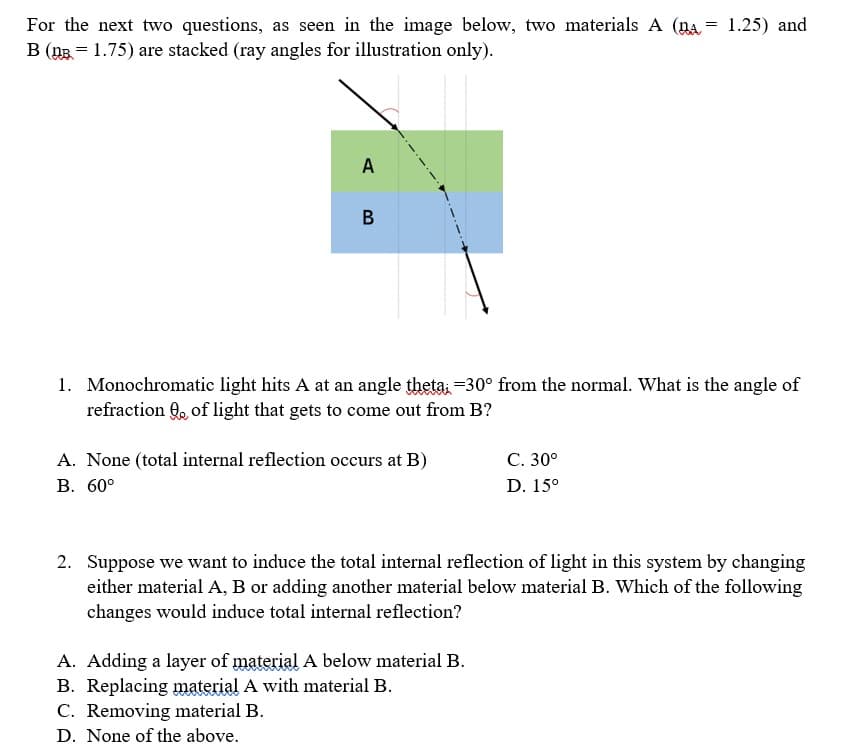For the next two questions, as seen in the image below, two materials A (na = 1.25) and B (n=1.75) are stacked (ray angles for illustration only). A B 1. Monochromatic light hits A at an angle theta, -30° from the normal. What is the angle of refraction of light that gets to come out from B? A. None (total internal reflection occurs at B) B. 60° C. 30° D. 15⁰ 2. Suppose we want to induce the total internal reflection of light in this system by changing either material A, B or adding another material below material B. Which of the following changes would induce total internal reflection? A. Adding a layer of material A below material B. B. Replacing material A with material B. C. Removing material B. D. None of the above.
For the next two questions, as seen in the image below, two materials A (na = 1.25) and B (n=1.75) are stacked (ray angles for illustration only). A B 1. Monochromatic light hits A at an angle theta, -30° from the normal. What is the angle of refraction of light that gets to come out from B? A. None (total internal reflection occurs at B) B. 60° C. 30° D. 15⁰ 2. Suppose we want to induce the total internal reflection of light in this system by changing either material A, B or adding another material below material B. Which of the following changes would induce total internal reflection? A. Adding a layer of material A below material B. B. Replacing material A with material B. C. Removing material B. D. None of the above.
Principles of Physics: A Calculus-Based Text
5th Edition
ISBN:9781133104261
Author:Raymond A. Serway, John W. Jewett
Publisher:Raymond A. Serway, John W. Jewett
Chapter25: Reflection And Refraction Of Light
Section: Chapter Questions
Problem 6OQ
Related questions
Question

Transcribed Image Text:For the next two questions, as seen in the image below, two materials A (na = 1.25) and
B ( 1.75) are stacked (ray angles for illustration only).
A
B
1. Monochromatic light hits A at an angle theta, -30° from the normal. What is the angle of
refraction of light that gets to come out from B?
A. None (total internal reflection occurs at B)
B. 60°
C. 30°
D. 15°
2. Suppose we want to induce the total internal reflection of light in this system by changing
either material A, B or adding another material below material B. Which of the following
changes would induce total internal reflection?
A. Adding a layer of material A below material B.
B. Replacing material A with material B.
C. Removing material B.
D. None of the above.
Expert Solution
This question has been solved!
Explore an expertly crafted, step-by-step solution for a thorough understanding of key concepts.
Step by step
Solved in 3 steps

Knowledge Booster
Learn more about
Need a deep-dive on the concept behind this application? Look no further. Learn more about this topic, physics and related others by exploring similar questions and additional content below.Recommended textbooks for you

Principles of Physics: A Calculus-Based Text
Physics
ISBN:
9781133104261
Author:
Raymond A. Serway, John W. Jewett
Publisher:
Cengage Learning

Glencoe Physics: Principles and Problems, Student…
Physics
ISBN:
9780078807213
Author:
Paul W. Zitzewitz
Publisher:
Glencoe/McGraw-Hill

University Physics Volume 3
Physics
ISBN:
9781938168185
Author:
William Moebs, Jeff Sanny
Publisher:
OpenStax

Principles of Physics: A Calculus-Based Text
Physics
ISBN:
9781133104261
Author:
Raymond A. Serway, John W. Jewett
Publisher:
Cengage Learning

Glencoe Physics: Principles and Problems, Student…
Physics
ISBN:
9780078807213
Author:
Paul W. Zitzewitz
Publisher:
Glencoe/McGraw-Hill

University Physics Volume 3
Physics
ISBN:
9781938168185
Author:
William Moebs, Jeff Sanny
Publisher:
OpenStax